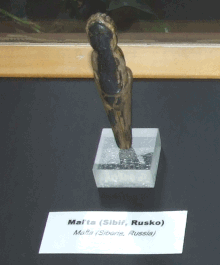Figurines of Venus from Malta
The Venus figurines of Malta are a series of Upper Paleolithic depictions of the female body from the eponymous site of Malta , which is 80 km from the Siberian Irkutsk in Russia . The age of the figurines is given as around 20,000 years. They therefore come from the Gravettia . The figurines are kept in the Hermitage in St. Petersburg.
In 1979 Delporte named the number of figures found (including statuettes that have been preserved in fragments) as 29. The figures are between 3.1 cm and 13.6 cm tall. The majority are made of ivory , only two specimens are made of reindeer antlers . Several statuettes show women in stylized clothing, and the face is also shown quite often. Both are otherwise rare in Paleolithic figurines. In this respect, the figurines from Malta resemble the Venus figurines from Bouret , another Paleolithic site near Malta.
Holes made on the figurines suggest that they were worn as pendants or amulets. However, with some of the feet, not the head, are provided with a hole, so that they were carried with the head down, similar to the bird pendants that are also common there.
Site Malta
The statuettes were found in a field station near Malta ( Irkutsk Oblast ) near Lake Baikal in Siberia . This excavation site should not be confused with the Bronze Age site on the Mediterranean island of Malta ( Tempelaġar Qim temple complex on Malta ). The Siberian Malta appears in the literature, especially in the Anglo-Saxon area, often in the spelling "Mal'ta".
The paleolithic site was discovered by Mikhail Gerasimov in 1928 and consists of several sites from a larger settlement. Structures of houses built from bones and a child's grave with grave goods have also made the site internationally known. The settlement is located about 85 km northwest of Irkutsk on the left bank of the Angara , which flows out of Lake Baikal. The statuettes were excavated by the Russian archaeologists N. Zamiatmine, GP Sosnovskii and Michail Gerasimow, among others.
literature
- Robert G. Bednarik: Pleistocene Palaeoart of Asia . In: Arts 2, 2, 2013, pp. 46–76 ( PDF )
- Claudine Cohen: La femme des origines. Images of the femme in the prehistoire occidentale. Belin-Herscher, Paris 2003, p. 113.
- Jan Jelinek: The great lexicon of images of man in prehistoric times . Bertelsmann-Lexikon-Verlag, Gütersloh 1972. (Fig. Of the Venus figurines from Malta: pp. 315, 334, 377, 385, 393, 394.)
- Karl H. Schlesier: More on the Venus Figurines . In: Current Anthropology 42, 2001, pp. 410-412.
- Olga Soffer, James M. Adovasio, David C. Hyland: Reply to 'More on the Venus Figurines'. In: Current Anthropology 42, 2001, pp. 410-412.
- Olga Soffer, James M. Adovasio, David C. Hyland: The "Venus" Figurines In: Current Anthropology 41,4 (2001) 511-537 (with images on p. 534, Fig. 15, online , PDF)
- Henri Delporte : L'image de la femme dans l'art préhistorique. Paris 1993.
- Zoya A. Abramova: L'art paléolithique d'Europe orientale et de Sibérie . Jérôme Millon, Grenoble 1992.
- Michail M. Gerasimov: The Paleolithic site of Malta: excavations of 1956-1958 . In: Henry N. Michael (Ed.): The Archeology and Geomorphology of Northern Asia . No. 5, pp. 3-32, Arctic Institute of North America, University of Toronto (from Russian sources), 1964.
Web links
- The Mal'ta - Buret 'venuses and culture in Siberia. from Don's Maps website
- Mal'ta (about 20,000 BC). Metropolitan Museum site with a brief description of a Malta figurine
See also
- Venus figurine
- Upper Paleolithic minor art
- Venus figurines by Kostenki
- Venus of Willendorf
- Venus of Lespugue
- Venus from Galgenberg
Individual evidence
- ^ Claudine Cohen: La femme des origines. Images of the femme in the prehistoire occidentale. Belin-Herscher, Paris 2003, p. 113.
- ^ Henri Delporte : L'image de la femme dans l'art préhistorique. Paris 1993, p. 197.
- ^ Richard G. Lesure: Interpreting Ancient Figurines. Context, Comparison, and Prehistoric Art , Cambridge University Press, Los Angeles 2011, p. 76.
- ^ Henri Delporte: L'image de la femme dans l'art préhistorique. Paris 1993, p. 193.
